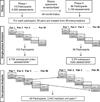The Influence of Disease Severity of Preceding Clinical Cases on Pathologists' Medical Decision Making
- PMID: 27037007
- PMCID: PMC5045742
- DOI: 10.1177/0272989X16638326
The Influence of Disease Severity of Preceding Clinical Cases on Pathologists' Medical Decision Making
Abstract
Background: Medical decision making may be influenced by contextual factors. We evaluated whether pathologists are influenced by disease severity of recently observed cases.
Methods: Pathologists independently interpreted 60 breast biopsy specimens (one slide per case; 240 total cases in the study) in a prospective randomized observational study. Pathologists interpreted the same cases in 2 phases, separated by a washout period of >6 months. Participants were not informed that the cases were identical in each phase, and the sequence was reordered randomly for each pathologist and between phases. A consensus reference diagnosis was established for each case by 3 experienced breast pathologists. Ordered logit models examined the effect the pathologists' diagnoses on the preceding case or the 5 preceding cases had on their diagnosis for the subsequent index case.
Results: Among 152 pathologists, 49 provided interpretive data in both phases I and II, 66 from only phase I, and 37 from phase II only. In phase I, pathologists were more likely to indicate a more severe diagnosis than the reference diagnosis when the preceding case was diagnosed as ductal carcinoma in situ (DCIS) or invasive cancer (proportional odds ratio [POR], 1.28; 95% confidence interval [CI], 1.15-1.42). Results were similar when considering the preceding 5 cases and for the pathologists in phase II who interpreted the same cases in a different order compared with phase I (POR, 1.17; 95% CI, 1.05-1.31).
Conclusion: Physicians appear to be influenced by the severity of previously interpreted test cases. Understanding types and sources of diagnostic bias may lead to improved assessment of accuracy and better patient care.
Keywords: bias; biopsy; breast; cancer; diagnosis; interpretation; sequential context effects.
© The Author(s) 2016.
Figures



References
-
- Egglin TK, Feinstein AR. Context bias. A problem in diagnostic radiology. JAMA. 1996;276(21):1752–1755. - PubMed
-
- Page DL, Rogers LW. Combined histologic and cytologic criteria for the diagnosis of mammary atypical ductal hyperplasia. Human pathology. 1992;23(10):1095–1097. - PubMed
-
- Harris, Jay R, Lippman ME, Osborne K, Morrow M. Diseases of the Breast. Lippincott Williams & Wilkins; 2012.
-
- O'Malley FP, Pinder SE. Breast Pathology. Elsevier; 2006.
-
- Ricci S, Celani M, Righetti E. Development of clinical guidelines: methodological and practical issues. Neurological Sciences. 2006;27(3):s228–s230. - PubMed
Publication types
MeSH terms
Grants and funding
LinkOut - more resources
Full Text Sources
Other Literature Sources
Medical

